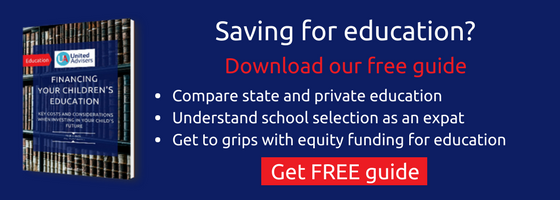The choice of educational institutes represents one of the biggest financial and parental decisions. University fees are steadily increasing globally meaning financial pressures on parents are also on the rise.
A HSBC study of 6,000 parents across 15 countries, found that 85% of parents pay towards their children’s university education.
What is worrying about this report is that 60% of parents are willing to go into debt to fund their child’s education. Fortunately, there are some smart ways you can begin to finance your child’s education so you can safely remain in the debt-free 40%.
Your financial requirements will depend on when your children are likely to enter a free paying structure. Is this something that you are considering from primary school or are you looking towards saving for college fees?
This guide is designed to accommodate a range of financial and educational situations and simply requires you to reflect on timings of your financial commitments. We will guide you through the key considerations when starting to plan.
Where are you likely to start paying fees?
There are significant differences in the costs between different countries and institutions. For example, when considering university fees the US and UK now rank amongst the most expensive countries.
Germany is one of the most affordable countries for university education as they have no tuition fees. Value Colleges found that, in addition to Germany, there are over 40 countries globally that offer free post-secondary education including Argentina, Denmark, Greece and Norway. Countries such as Scotland offer free university education for residents but charge for similar fees to UK institutions for foreign students.
You may be situated in a part of the world that has a free school structure and a low cost of living. You may, however, not be satisfied with the quality of the education provided, or prefer your child attends an international school to gain specific qualifications, such as the International Baccalaureate or A-Levels.
So, whilst living in Thailand is relatively cost effective, a place at the top private school, Phuket International Academy, costs around $14,000 a year. This will still be less than a top school in the UK or Canada, but is the equivalent cost of a year’s study at Cambridge University.
If you want to look at the best schools and their fees there is a good overview of the 100 best schools provided here.
Are grants available?
Most top private education has a grants system. For universities there will often be additional grants, or support for fields of study that struggle to recruit or are under represented.
For example, many top science programs offer additional funding for females to encourage them into this particular field of study.
If your child already has a clear career path, or would benefit from a grant due to other means, it is important to factor this into your calculations.
What are the associated costs?
Even the most careful planners can be caught out by the incremental costs of certain institutions. This is why this is such an important step in working out how much you will need for financing your child’s education.
This can include boarding fees, uniform costs, school trips, extra-curricular activities and ‘voluntary’ donations to the schools.
Trips and extra curricular activities are an important part of the social fabric within educational institutes, so it is worth considering how much excursions and sports are likely to cost over the duration of your child’s education.
Many educational institutions can also have high registration fees and/or entrance fees in addition to school fees. It is worth spending time reviewing the total cost and then factoring in annual price increases!
Will you be saving for living costs?
You may not want to contribute solely to fees.
As a parent you may want your child to leave education 100% debt-free. Whilst not financially viable for all, it offers a great opportunity for your child.
If you want to contribute towards university or college living costs it is worth establishing a provisional budget. Your child may still be too young to be able to give an indication of their location preference. Should this be the case it is worth considering the cost of supporting living costs within a major city as this is often the more popular choice.
How to calculate how much you need to save
Now you have established the key considerations in your savings plan, you will be able to begin calculating your financial plan. This includes reviewing:
- How many years you have to save
- What the rate of inflation is likely to be
- If you have any lump sum investments for education
- How much you can afford to save each month
- How much interest you are likely to gain on your savings
- You will need to work this out for each child
Calculating how much you need to save for university fees for your two year old:
- $8 000 per year for 4 years = $32 000
- Cost of living for 4 years = $24 000
- Total = $66 000
- Rate of inflation @1.5% = $83 753
How to calculate:
- Number of years to save = 16
- Lump sum investment = $5 000
- Monthly savings = $1 000
- Savings after year one = $17 000
- Interest rate @3% = $17 510
Based on this rate of saving it would take you 7 years to save enough for university fees. In this time you would have saved $92 195. If you had twins and wanted to save for both of them ($167 506) then you would be saving for just over 13 years based on the same contributions.
Don’t panic!
If you’ve worked out how much you need to save and this isn’t achievable then don’t panic.
There are a number of options to consider.
Schools will, for example, often have grants and scholarships available. Also consider other factors that you can influence, for instance, would looking at a different location make your goal achievable? What would yield a higher rate of interest?
Available funding options
You can fund your child’s education a number of ways including mortgage planning products and home equity planning strategies. In addition to this, there are interesting tax breaks that you may qualify for as an expat.
When reviewing your financial plan it is worth having a conversation with Grandparents; they may have plans of their own to help with educational expenses.
Consider the equity route
If you are going to invest for 10+ years then equity investment may be a good option for you. Interest rates are currently low for most current accounts, so you may find yourself in a country where inflation outstrips annual interest.
A good way of balancing equity investment is to reduce the risk in your portfolio as you approach your withdraw date. Whilst you are unlikely to change funds for the first 4/5 years, you should review their performance annually to ensure you will achieve your financial goals; you can then diversify your portfolio accordingly to ensure you remain on target.
We hope these tips for financing your child’s education have helped understand the likely costs involved. If you would like to know more about your investment options or potential tax breaks please get in touch today.





